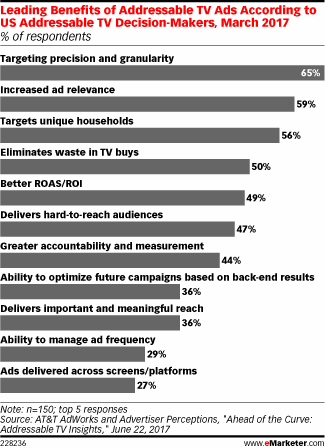You may think that advanced audiences only apply to advanced TV — but in fact, you can use advanced audiences for linear TV as well.
Let’s back up. What do these terms mean? In our last blog on TV, we broke down the differences between linear and advanced TV — essentially, traditional vs. non-traditional TV — as well as how they each contribute to the state of television advertising today. Advertisers are projected to align with the growing market trend toward connected TV adoption and reallocate their budget to this channel. As they do this, they need to think about how they can maximize their investment to prove ROI.
There are several new technology innovations that allow TV marketers to maximize their media investment. From buying audiences based on real-world behaviors, to targeting specific households, to measuring the impact of ads on store visits, there are many new factors helping TV marketers target their audiences better and gain a more complete view of the consumer journey.
Demos Are Out, Audiences Are In
Traditionally, TV inventory was bought and sold using age or gender demographics. You’d know the demographic of viewers for a particular show — say women, 18–49 — and buy inventory for that show assuming you’d reach that intended demographic.
Now, however, audiences are the dominant currency for buying TV inventory. A buyer can create their own audience needs — such as eco-conscious families looking for a hybrid vehicle — and then make buys based on those audience criteria.
For advertisers honing in on these audiences, new technology such as location intelligence is invaluable. It enables marketers to map the offline consumer journey through real-world actions such as in-store visits, dwell time, visit frequency, brand loyalty, cross-shopping activities, and more. Getting this granular with the data enables marketers to base their audiences on specific, proven consumer behaviors, ensuring they are getting the most refined audiences possible for targeting.
Using Addressable TV to Target Specific Households
To go one step further, TV marketers can actually target specific households with certain ads. Using addressable TV, advertisers can purchase audiences using household level profiling and segmentation to deliver different TV ads to different households watching the same program. By identifying the segments of consumers who are most likely to purchase their product and then targeting them directly, marketers can deliver much more customized content that resonates with their consumers.
Marketers are decidedly in favor of using addressable TV for a variety of reasons. According to eMarketer, the leading benefits of addressable TV ads according to key decision makers are targeting precision and granularity (65%), increased ad relevance (59%), and targeting unique households (56%).

What’s more, addressable TV is particularly useful when it is combined with digital to create a cross-channel campaign. For example, an advertiser can target a specific household watching Project Runway on TV with an ad during the program, then deliver an ad to them on mobile afterward, when they’re on Instagram. When paired with location data, this kind of multiple-platform targeting can prove especially powerful, even directing the viewer to certain locations featuring the product advertised.
Tying It All Together With Measurement
Perhaps the most important aspect of audience targeting is that it enables a marketer to follow the consumer journey. This includes determining whether the target audience visited an actual location after viewing a TV ad. A store visit is a key KPI for TV advertising, as it shows the direct impact of the ad on real-world behavior — and intent to at least browse the store, if not make an actual purchase.
By revealing how audiences act in the real world after viewing TV ads, footfall attribution moves TV from simply a branding ploy into the realm of direct measurement. With new technologies available, marketers can not only see how their TV campaigns are truly performing against their target audience, but they can then reallocate their media dollars accordingly and maximize ROI.



